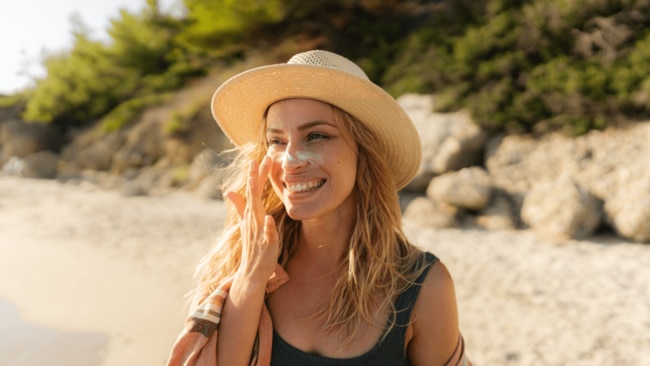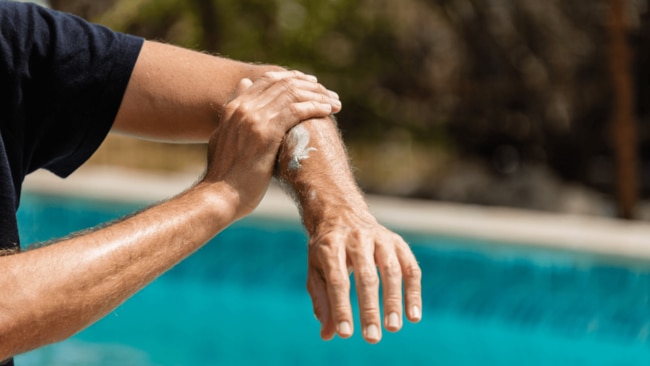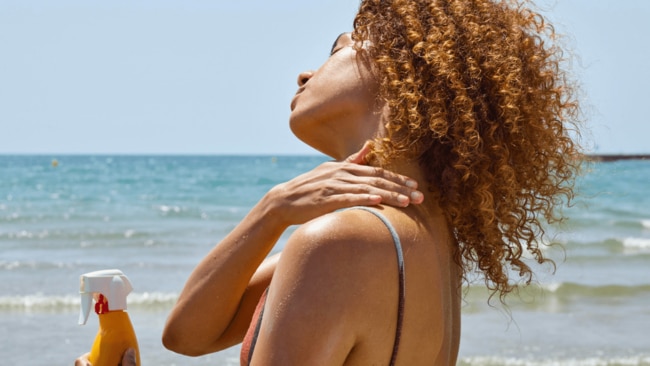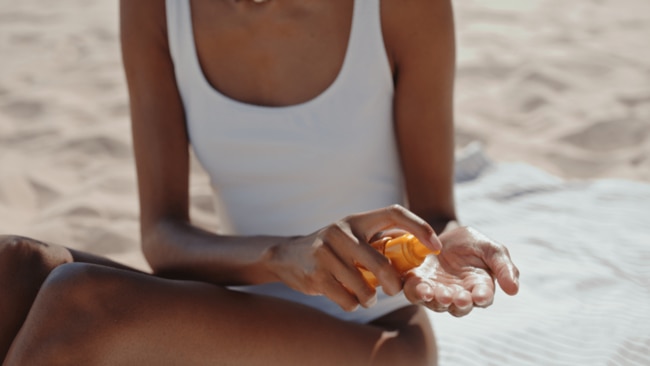SPF 101: Everything you need to know about choosing a sunscreen
We've done the hard work for you

Lifestyle
Don't miss out on the headlines from Lifestyle. Followed categories will be added to My News.
Sunscreen is the most important accessory in Australia so how do you choose the right one? We asked the experts.
By mid-December, most Australians will have already felt the full effects of our country’s glorious summers.
Hot, heady days give way to humid, claggy nights, and the urge to be submerged in water at any given time increases exponentially. We also tend to spend more time outside, socialising with friends, exercising and generally making the most of the warm weather.
As wonderful as it is, summers Down Under are not for the faint-hearted – or the unprotected skin. The ultraviolet radiation (UV) index reaches 11 in most parts of Australia (defined as ‘extreme’) and it can take only minutes to burn – even on cloudy days.
With that in mind, there’s no time like the present to brush up on your knowledge about all things sunscreen, to ensure you’re doing the most to protect yourself from the sun’s harsh rays all summer long.

The benefit of sunscreen
“Australia has the highest rate of skin cancer in the world,” Professor Anne Cust, chair of Cancer Council’s National Skin Cancer Committee, tells Body+Soul. “Two in three Australians will be diagnosed with skin cancer in their lifetime, and it unfortunately claims the lives of over 2,000 Australians every year. ”
That being said, it’s an entirely preventable disease. “Using sunscreen regularly has been shown to reduce the risk of skin cancer, including the deadliest form, melanoma,” says GP Dr Prasanthi Purusothaman. “When applied properly, sunscreen protects the skin against UV damage including sunburn and tanning. [It] can also protect against sun spots and premature ageing.”
Studies also show that regular sunscreen use, particularly before the age of 10 years old, can reduce the risk of melanoma by 40 per cent, and there is “evidence to show that daily use of sunscreen can prevent most types of skin cancer (both melanoma and non melanoma),” she says.
Skin damage is a cumulative process. One bad burn will not guarantee a melanoma, just as dodging severe burns your entire life doesn’t mean you’re not at risk. But by wearing sunscreen every day, you significantly mitigate both risk factors, reducing your chance of developing skin cancer throughout your life.
There’s a long-held misconception that sunscreen is greasy, thick and altogether terrible for anyone with oily skin – not to mention leaving a white cast, making it hard to apply makeup. But while that may have been true in the past, it’s far from the case now – you just need to know what to look for.

SPF: what it means and how it works
UV is a form of radiation present in sunlight, which the Cancer Council dubs the “invisible killer that you can’t see or feel”.
To get technical for a moment, there are two kinds of UV radiation that can affect humans on earth: UVA, which Purusothaman says “causes long-term damage like wrinkles, hyperpigmentation, sagging and roughening (elastosis), and also contributes to skin cancer (think A for ‘ageing’),” and UVB, which “ penetrates the top layer of skin and is the main cause of skin damage and skin cancer (think B for burning).’
Sun Protection Factor (SPF) is a measure of how well a sunscreen protects the skin from sunburn, but there are limitations to the measurement. “The SPF number only tells you how long the sun’s UVB rays would take to redden your skin if you apply the sunscreen exactly as directed compared with the amount of time without sunscreen, and also the amount of UVB radiation permissed through the skin with the sunscreen applied properly,” Purusothaman tells Body+Soul.
For example, if you use an SPF50 sunscreen correctly, it would take 50 times longer to burn than if you used no sunscreen.
“That’s why we always recommend applying sunscreen 20 minutes before being exposed to UV, then liberally every two hours or after swimming, sweating or towel drying,” says Cust.

To properly protect the skin from UV radiation, it’s important to use a sunscreen that blocks both wavelengths – which is called a broad-spectrum sunscreen – alongside other forms of sun protection, including protective eyewear, clothing and a hat.
“Broad-spectrum sunscreen filters both UVA and UVB radiation and have been tested [by the TGA] to strict standards to filter both types of rays,” says Purusothaman. “To be listed as ‘broad spectrum’ the sunscreen must also achieve a UVA protection factor equal to at least one-third of the labelled SPF.”
In Australia, the Therapeutic Goods Administration heavily regulates sunscreen marketing, packaging and formulation – a standard necessitated by the harsh climates and high UV all year round, which makes our sunscreens the gold standard across the world.
All Australian sunscreens will be marked with an AUSTL number on the product, which means it’s been approved (registered or listed) by the TGA, a process Purusothaman says means verifying “pre-approved ingredients and filters with evidence and safety checks, strict testing for SPF and broad spectrum claims, and quality assurance.”

Different kinds of sunscreen
If you’ve ever ventured down the sunscreen aisle at the chemist, you’ll be well aware just how many types of sunscreen there are on the market. Beyond their UV filters, terms like primary, secondary, physical, chemical and mineral are often thrown around – and don’t do much to clarify things for the everyday shopper looking to protect their skin.
Primary sunscreens are products designed to be used for sun protection in the first instance, whereas “secondary sunscreens are products with a primary purpose other than sun protection that also contain sun screening agents,” says Purusothaman, which means they’re not exempt from being listed by the TGA – think a BB cream, lip balms or moisturiser that also includes an SPF of over 15.
When it comes to chemical vs mineral, that’s where things get a little hairy. There are many myths around the so-called detractors of chemical sunscreens, namely that they aren’t as good as physical sunscreens, contain endocrine disruptors, and aren’t reef safe – myths that Purusothaman wholeheartedly disputes, based on scientific evidence.
There’s also a misconception that chemical sunscreens absorb the sun, while physical sunscreens reflect it, which Purusothaman says “is not true”.
“Both sunscreens work predominantly through absorption of UV rays and conversion to harmless heat,” she continues. “One is not superior to the other, the heat itself generated from sunscreen absorption is not what is damaging the skin, it is the UV radiation causing DNA damage.”

When it comes to the mode of application, there are creams, serums, sprays and sticks to choose from, but the Cancer Council recommends everyone use a cream or lotion sunscreen as they provide a more reliable way of ensuring adequate coverage.
While aerosol sunscreens can be great for accessing hard-to-reach parts of your body, “It’s difficult to obtain the amount of sunscreen to the body that is necessary to get adequate UV protection…potentially leaving Australians’ skin inadequately protected from UV radiation and increasing risk of skin cancer,” says Cust.
That being said, experts say the best kind of sunscreen is the one you’ll use every single day, and remember to reapply.
“Facial SPF use is something you want to make a habit of so applying it every day is a good thing,” Matthews tells Body+Soul. “SPF application should be like brushing your teeth! Don’t leave home without doing it.”

Your sunscreen checklist
#1. Choose a broad-spectrum sunscreen – to ensure you’re protected from both UVA and UVB radiation.
#2. Opt for SPF50+ – To maximise your protection in the sun, and the length of efficacy.
#3. Measure your application – “When applying sunscreen, you need at least one teaspoon per limb, one for the front of the body, one for the back and one for the head,” says Cust. “A full body application for an adult should be at least 35mL or seven teaspoons.”
#4. Let it set – When you apply the sunscreen first thing in the morning, wait five to 10 mins before putting on makeup to allow the product to settle.
#5. Apply before you leave the house – “Sunscreen needs to be applied 20 minutes before going outdoors,” says Cust.
#6. Pair sunscreen with other modes of protection – “Slip on protective clothing; slop on SPF30 (or higher) broad-spectrum, water-resistant sunscreen; slap on a broad-brimmed hat; seek shade and slide on sunglasses,” instructs Cust.
#7. Regularly reapply – “Sunscreen should be reapplied every two hours if you are spending time outdoors,” says Cust. “As sunscreen can be easily wiped off or lost through perspiration, you should also reapply after swimming, sweating or towel drying.”
More Coverage
Originally published as SPF 101: Everything you need to know about choosing a sunscreen





